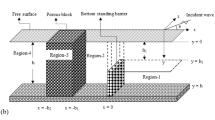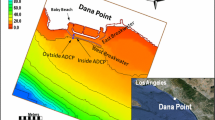Abstract
A mathematical model based on the three-dimensional (3-D) boundary element method (BEM), including porous and non-porous breakwaters, is developed to determine the wave trapping characteristics of porous breakwater over the partially reflecting walls with variable bathymetry. In this formulation, a special form of Green’s function is utilized to solve the Laplace equation in the 3-D domain to enhance the numerical accuracy. The order of convergence of the present numerical scheme shows a better convergence rate than simple Green’s function. The numerical scheme with and without the porous breakwater is compared with the analytical studies of Yu et al. (1994) and Lee (1969), respectively. In addition, the numerical simulation for sloping bathymetry is conducted and compared with the analytical results of Wang et al. (2011). The numerical validation exhibits good agreement with and without porous breakwaters. Based on validation, the current numerical scheme is implemented on the realistic Visakhapatnam Port, Andhra Pradesh, India, at four different synthetic key locations S1 to S4 to analyze the hydrodynamic performance of porous and non-porous breakwaters. Wave amplification is determined for different porosity parameters, including variable linear resistance and inertial coefficient, and different reflecting coefficients of the port wall. Moreover, the wave amplitude within the Visakhapatnam Port is also estimated through a contour plot with and without porous breakwaters to identify the safe location for the moored ship. Overall, the porosity of the breakwaters and partial reflection coefficient on the port wall plays a significant role in inducing or reducing the resonance inside the port.



















Similar content being viewed by others
Data availability
The datasets generated during and/or analysed during the current study are available from the corresponding author on reasonable request.
References
Bakhti Y, Chioukh N, Hamoudi B, Boukhari M (2017) A multi-domain boundary element method to analyze the reflection and transmission of oblique waves from double porous thin walls. J Marine Sci Appl 16:276–285. https://doi.org/10.1007/s11804-017-1421-y
Bellotti G, Briganti R, Mario G, Franco L (2012) Model analysis of semi-enclosed basins. Coast Eng 64:16–25. https://doi.org/10.1016/j.coastaleng.2012.02.002
Bellotti G, Franco L (2011) Measurement of long waves at the harbor of Marina di Carrara. Italy Ocean Dyn 61:2051–2059. https://doi.org/10.1007/s10236-011-0468-6
Cerrato A, Gonzalez JA, Rodriguez-Tembleque L (2016) Boundary element formulation of the mild-slope equation for harmonic water waves propagating over unidirectional variable bathymetries. Eng Anal Bound Elem 62:22–34. https://doi.org/10.1016/j.enganabound.2015.09.006
Chang Y, Wang EH (2017) A harbor resonance model with reflecting, absorbing and transmitting boundaries. Open Construct Build Technol J 11:413–432. https://doi.org/10.2174/187483680171101
Chen HS (1986) Effects of bottom friction and boundary absorption on water wave scattering. Appl Ocean Res 8:99–104. https://doi.org/10.1016/S0141-1187(86)80004-9
Chou CR, Han WY (1993) Wave-induced oscillations in harbours with dissipating quays. Coast Eng Japan 36:1–23. https://doi.org/10.1080/05785634.1993.11924570
Chou CR, Han WY (1994) Oscillations induced by irregular waves in harbors. Proceedings of the 24th International Conference on Coastal Engineering. ASCE, New York, pp. 2987–3001. https://doi.org/10.9753/icce.v24.%25p
Dalrymple RA, Losada MA, Martin PA (1991) Reflection and transmission from porous structures under oblique wave attack. J Fluid Mech 224(1):625–644. https://doi.org/10.1017/S0022112091001908
Dong G, Zheng Z, Ma X, Huang X (2020) Characteristics of low-frequency oscillations in the Hambantota Port during the southwest monsoon. Ocean Eng 204:107408. https://doi.org/10.1016/j.oceaneng.2020.107408
Gao J, Ma X, Dong G, Wang G, Ma Y (2015) Improvements on the normal mode decomposition method used in harbor resonance. Proc Inst Mech Eng Part M J Eng Marit Environ 229(4):397–410. https://doi.org/10.1177/1475090214527269
Gao J, Ma X, Dong G, Wang G, Ma Y (2016) Numerical study of transient harbor resonance induced by solitary waves. Proc Inst Mech Eng Part M J Eng Marit Environ 230(1):163–176
Gao J, Ji C, Gaidai O, Liu Y, Ma X (2017) Numerical investigation of transient harbor oscillations induced by N-waves. Coast Eng 125:119–131. https://doi.org/10.1016/j.coastaleng.2017.03.004
Gao J, Zhou X, Zang J, Chen Q, Zhou L (2018) Influence of offshore fringing reefs on infragravity period oscillations within a harbor. Ocean Eng 158:286–298. https://doi.org/10.1016/j.oceaneng.2018.04.006
Gao J, Ma X, Dong G, Zang J, Zhou X, Zhou L (2019) Topographic influences on transient harbor oscillations excited by N-waves. Ocean Eng 192:106548. https://doi.org/10.1016/j.oceaneng.2019.106548
Gao J, Zhou X, Zhou L, Zang J, Chen H (2019) Numerical investigation on effects of fringing reefs on low-frequency oscillations within a harbor. Ocean Eng 172:86–95. https://doi.org/10.1016/j.oceaneng.2018.11.048
Gao J, Ma X, Dong G, Zang J, Ma Y, Zhou L (2019) Effects of offshore fringing reefs on the transient harbor resonance excited by solitary waves. Ocean Eng 190:106422. https://doi.org/10.1016/j.oceaneng.2019.106422
Gao J, Ma X, Zang J, Dong G, Ma X, Zhu Y, Zhou L (2020) Numerical investigation of harbor oscillations induced by focused transient wave groups. Coast Eng 158:103670. https://doi.org/10.1016/j.coastaleng.2020.103670
Gao J, Ma X, Dong G, Chen H, Liu Q, Zang J (2021) Investigation on the effects of Bragg reflection on harbor oscillations. Coastal Eng 170:103977. https://doi.org/10.1016/j.coastaleng.2021.103977
Gao J, Ma X, Chen H, Zang J, Dong G (2021) On hydrodynamic characteristics of transient harbor resonance excited by double solitary waves. Ocean Eng 219:108345. https://doi.org/10.1016/j.oceaneng.2020.108345
Gerber M (1986) Modelling dissipation in harbour resonance. Coast Eng 10:211–252. https://doi.org/10.1016/0378-3839(86)90043-8
Guerrini M, Bellotti G, Fan Y, Franco L (2014) Numerical modelling of long waves amplification at Marina di Carrara Harbour. Appl Ocean Res 48:322–330. https://doi.org/10.1016/j.apor.2014.10.002
Guha A (2012) Development of a computer program for three-dimensional frequency domain analysis of zero speed first order wave body interaction, Dissertation, Texas A&M University. College Station, TX
Hagiwara K (1984) Analysis of upright structure for wave dissipation using integral equation. Proceedings of 19th International Conference on Coastal Engineering. ASCE, Houston, USA, 2810–2826
Hess JL, Smith AMO (1967) Calculation of potential flow about arbitrary bodies. Prog Aerosp Sci 8:1–138. https://doi.org/10.1016/0376-0421(67)90003-6
Huang Z (2007) Wave interaction with one or two rows of closely spaced rectangular Cylinders. Ocean Eng 34:1584–1591. https://doi.org/10.1016/j.oceaneng.2006.11.002
Isaacson M, Baldwin J, Premasiri S, Yang G (1999) Wave interactions with double slotted barriers. Appl Ocean Res 21(2):81–91. https://doi.org/10.1016/S0141-1187(98)00039-X
Isaacson M, Qu S (1990) Waves in a harbour with partially reflecting boundaries. Coast Eng 14:193–214. https://doi.org/10.1016/0378-3839(90)90024-Q
Ippen AT, Goda Y (1963) Waves induced oscillation in harbors: the solution for a rectangular harbor connected to the open sea. Report No. 59. Hydrodynamics Laboratory, MIT
John F (1950) On the motion of floating bodies II Simple harmonic motions. Commun. Pure Appl Math 3(1):45–101. https://doi.org/10.1002/cpa.3160030106
Kaligatla RB, Tabssum S, Sahoo T (2018) Effect of bottom topography on wave scattering by multiple porous barriers. Meccanica 53(4):887–903
Kaligatla RB, Tabssum S, Sahoo T (2021) Surface gravity wave interaction with a partial porous breakwater in a two-layer ocean having bottom undulations. Waves in Random and Complex Media 1–32. https://doi.org/10.1080/17455030.2021.1976878
Kofoed-Hansen H, Kerper DR, Sørensen OR, Kirkegaard J (2005) Simulation of long wave agitation in ports and harbours using a time-domain Boussinesq model. Fifth International Symposium on Ocean Wave Measurement and Analysis (WAVES), Madrid, Spain, pp 1–11
KumarGulshan P (2017) Extreme wave-induced oscillation in Paradip Port under the resonance conditions. Pure Appl Geophys 174(12):4501–4516. https://doi.org/10.1007/s00024-017-1646-3
Kumar P, Gulshan (2018) Theoretical analysis of extreme wave oscillation in Paradip Port using a 3-D boundary element method. Ocean Eng 164:13–22. https://doi.org/10.1016/j.oceaneng.2018.06.029
Kumar P, Priya P, Rajni (2021) Boundary element modeling of multiconnected ocean basin in Visakhapatnam Port under the resonance conditions. China Ocean Eng 35(5):662–675. https://doi.org/10.1007/s13344-021-0058-4
Kumar P, Rupali (2018) Modeling of shallow water waves with variable bathymetry in an irregular domain by using hybrid finite element method. Ocean Eng 165:386–398. https://doi.org/10.1016/j.oceaneng.2018.07.024
Kumar P, Zhang H, Yuen DA, Kim KI (2013) Wave field analysis in a harbor with irregular geometry through boundary integral of Helmholtz equation with corner contributions. Comp Fluids 88:287–297. https://doi.org/10.1016/j.compfluid.2013.09.020
Koley S, Behera H, Sahoo T (2015) Oblique wave trapping by porous structures near a wall. J Eng Mech 141(3):04014122. https://doi.org/10.1061/(ASCE)EM.1943-7889.0000843
Lee HS, Williams AN (2002) Boundary element modeling of multidirectional random waves in a harbor with partially reflecting boundaries. Ocean Eng 29(1):39–58. https://doi.org/10.1016/S0029-8018(01)00006-3
Lee HS (2004) Boundary element modeling of multidirectional random wave diffraction by multiple rectangular submarine pits. Eng Ana Bound Elem 28:1149–1155. https://doi.org/10.1016/j.enganabound.2004.04.002
Lee JJ (1969) Wave induced oscillations in harbors of arbitrary shape. Dissertation, California Institute of Technology, Pasadena, California, USA
Lee JJ (1971) Wave-induced oscillations in harbours of arbitrary geometry. J Fluid Mech 45(2):375–394. https://doi.org/10.1017/S0022112071000090
Lee JJ, Raichlen F (1970) Resonance in harbors of arbitrary shape. Proceedings of the 12th Conference on Coastal Engineering. Washington, D. C., 131, pp 2163–2180. https://doi.org/10.9753/icce.v12.131
Leendertse JJ (1967) Aspects of a computational model for long-period water wave propagation. Research Memorandum, RM-5294-PR, The Rand Corporation, pp 179. https://www.rand.org/pubs/research_memoranda/RM5294.html
Liu Y, Li Y (2011) Wave interaction with a wave absorbing double curtain-wall breakwater. Ocean Eng 38:1237–1245. https://doi.org/10.1016/j.oceaneng.2011.05.009
Liu Y, Xie L, Zhang W (2014) The wave motion over a submerged Jarlan-type perforated breakwater. Acta Oceanol Sin 33(5):96–102. https://doi.org/10.1007/s13131-014-0471-0
Li Y, Liu Y, Teng B (2006) Porous effect parameter of thin permeable plates. Coast Eng J 48(4):309–336. https://doi.org/10.1142/S0578563406001441
Lopez M, Iglesias G, Kobayashi N (2012) Long period oscillations and tidal level in the Port of Ferrol. Appl Ocean Res 38:126–134. https://doi.org/10.1016/j.apor.2012.07.006
López M, Iglesias G (2014) Long wave effects on a vessel at berth. Appl Ocean Res 47:63–72. https://doi.org/10.1016/j.apor.2014.03.008
Ma X, Zheng Z, Zhang X, Dong G (2020) Numerical investigation on special modes with narrow amplification diagram in harbor oscillations. Ocean Dyn 70:1–19. https://doi.org/10.1007/s10236-019-01325-8
Mandal S, Behera H, Sahoo T (2016) Oblique wave interaction with porous, flexible barriers in a two-layer fluid. J Eng Math 100(1):1–31. https://doi.org/10.1007/s10665-015-9830-x
Miles J, Munk W (1961) Harbor Paradox. J. Waterw. Harb. Div. ASCE 87:111–130
Magdalena I, Rif’atin HQ, Reeve DE (2020) Seiches and harbour oscillations in a porous semi-closed basin. Appl Math Comput 369:124835. https://doi.org/10.1016/j.amc.2019.124835
Panchang V, Zhang J, Demirbilek Z (2008) Incorporating rubble mound jetties in elliptic harbor wave models. J Waterw Port Coast Ocean Eng 134:40–52. https://doi.org/10.1061/(ASCE)0733-950X(2008)134:1(40)
Raichlen F, Naheer E (1977) Wave induced oscillations of harbors with variable depth. 15th International Conference on Coastal Engineering, Honolulu, Hawaii, United States, pp 3536–3556. https://doi.org/10.1061/9780872620834.204
Rupali, Kumar P (2021) Mathematical modeling of arbitrary shaped harbor with permeable and impermeable breakwaters using hybrid finite element method. Ocean Eng 221:108551. https://doi.org/10.1016/j.oceaneng.2020.108551
Shi YY, Li ZF, Wu GX (2018) Motion of a floating body in a harbour by domain decomposition method. Appl Ocean Res 78:223–240. https://doi.org/10.1016/j.apor.2018.06.015
Sollitt CK (1972) Wave transmission through permeable breakwaters. 13th International Conference on Coastal Engineering. ASCE, Vancouver, Canada, pp 1827–1846
Sulisz W (2015) Wave propagation in a converging channel of arbitrary configuration. China Ocean Eng 29:771–782. https://doi.org/10.1007/s13344-015-0054-7
Sulisz W (2005) Wave propagation in channel with side porous caves. J Waterw Port Coast Ocean Eng 131(4):162–170. https://doi.org/10.1061/(ASCE)0733-950X(2005)131:4(162)
Tabssum S, Kaligatla RB, Sahoo T (2020) Gravity wave interaction with a porous breakwater in a two-layer ocean of varying depth. Ocean Eng 196:106816. https://doi.org/10.1016/j.oceaneng.2019.106816
Tabssum S, Kaligatla RB, Sahoo T (2020) Surface gravity wave interaction with a partial porous breakwater in the presence of bottom undulation. J Eng Mechanics 146(9):04020088
Wang G, Dong G, Perlin M, Ma X, Ma Y (2011) Numerical investigation of oscillations within a harbor of constant slope induced by seafloor movements. Ocean Eng 38(17–18):2151–2161. https://doi.org/10.1016/j.oceaneng.2011.09.033
Wehausen JV, Laitone EV (1960) Surface Waves. Encyclo Phy 3:446–778. https://doi.org/10.1007/978-3-642-45944-3_6
Yip TL, Sahoo T, Chwang AT (2001) Wave oscillation in a circular harbor with porous wall. J Appl Mech 68(4):603–607. https://doi.org/10.1115/1.1379955
Yu X, Chwang AT (1994) Wave-induced oscillation in harbor with porous breakwaters. J Waterw Port Coast Ocean Eng 120:125–144. https://doi.org/10.1061/(ASCE)0733-950X(1994)120:2(125)
Yu X (1995) Diffraction of water waves by porous breakwaters. J. Waterw. Port Coast Ocean Eng ASCE 121:275–328. https://doi.org/10.1061/(ASCE)0733-950X(1995)121:6(275)
Acknowledgements
The current research work is supported by Department of Applied Sciences (Mathematics), National Institute of Technology Delhi. We are thankful to the reviewers for their insightful and valusble suggestions to improve our manuscript.
Funding
This work was financially supported by the Department of Applied Science (Mathematics), National Institute of Technology, Delhi.
Author information
Authors and Affiliations
Corresponding author
Ethics declarations
Conflict of interest
The authors declare no competing interests.
Additional information
Publisher’s note
Springer Nature remains neutral with regard to jurisdictional claims in published maps and institutional affiliations.
Rights and permissions
About this article
Cite this article
Kumar, P., Priya, P. & Rajni Mathematical modelling of Visakhapatnam Port utilizing the porous and non-porous breakwaters with finite depth green function. Ocean Dynamics 72, 557–576 (2022). https://doi.org/10.1007/s10236-022-01519-7
Received:
Accepted:
Published:
Issue Date:
DOI: https://doi.org/10.1007/s10236-022-01519-7




